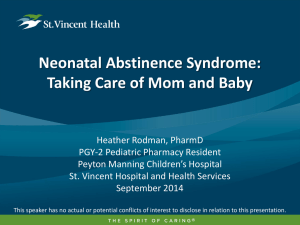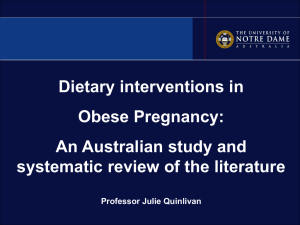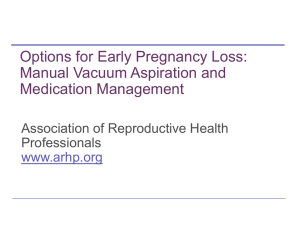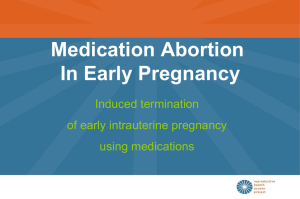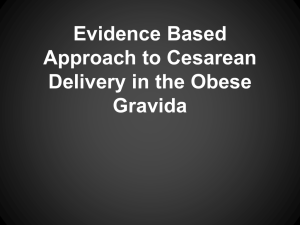Management of Early Pregnancy Loss
advertisement
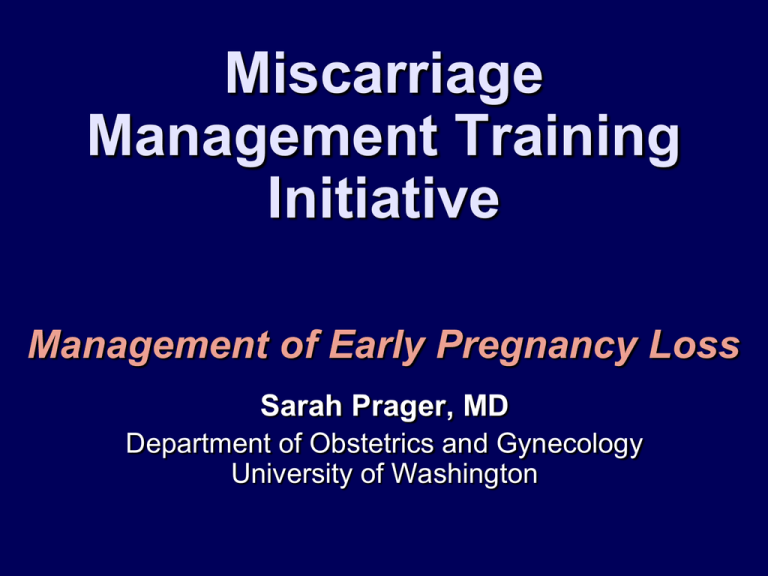
Miscarriage Management Training Initiative Management of Early Pregnancy Loss Sarah Prager, MD Department of Obstetrics and Gynecology University of Washington MM-TI Goals: Move miscarriage management from the operating room to the outpatient setting Train primary care clinicians and support staff in miscarriage management Purpose Expand patient access to prompt, appropriate care Improve patient safety Improve patient satisfaction Decrease costs Challenges and Solutions Difficult to influence physician practice patterns Target training during residency Use a systems approach (include faculty, residents, key administrative personnel and support staff) Clarification We are not talking about elective abortion We are teaching and promoting miscarriage management MVA Safety and Efficacy: Summary MVA is simple Easily incorporated into office setting Expanded pain management options Ultrasound as needed Patient-provider interaction Management of Early Pregnancy Loss Objectives Review etiologies of EPL Review the three methods of EPL management: — Expectant — Medical — Surgical Discuss benefits of outpatient EPL management Nomenclature Management of Early Pregnancy Loss Early Pregnancy Loss (EPL) Spontaneous Abortion (SAb) Miscarriage These all mean exactly the same thing! Background Management of Early Pregnancy Loss Spontaneous Abortion (SAb) most common complication of early pregnancy — 8–20% clinically recognized pregnancies — 13–26% all pregnancies — ~ 800,000 SABs each year in the US 80% of SAbs occur in 1st trimester Samantha 26 yo G2P1 presents to your office for a new ob visit. An ultrasound sows a CRL of 7mm but no cardiac activity. She wants to know why this happened. Risk Factors Management of Early Pregnancy Loss Age Prior SAb Smoking Alcohol Caffeine (controversial) Maternal BMI <18.5 or >25 Celiac disease (untreated) Cocaine NSAIDs High gravidity Fever Low folate levels Etiology Management of Early Pregnancy Loss 33% anembryonic 50% due to chromosomal abnormalities — Autosomal trisomies — Monosomy X — Polyploidies — Other Host factors 52% 19% 22% 7% — Structural abnormalities — Maternal infection/endocrinopathy/coagulopathy Unexplained Normal Implantation & Development Management of Early Pregnancy Loss Implantation: — 5-7 days after fertilization — Takes ~72 hours — Invasion of trophoblast into decidua Embryonic disc: — 1 wk post-implantation — If no embryonic disc, trophoblast still grows, but no embryo (anembryonic pregnancy) Embryonic disc embryonic/fetal pole U/S Dating in Normal Pregnancy Management of Early Pregnancy Loss Gestational Age (days) = Mean Sac Diameter (mm) + 30 OR Crown-Rump Length (mm) + 42 Clinical Presentation of EPL Management of Early Pregnancy Loss Bleeding Pain/cramping Falling or abnormally rising ßhCG Decreased symptoms of pregnancy No symptoms at all! Ultrasound Findings of EPL Management of Early Pregnancy Loss Anembryonic Pregnancy — No fetal pole with mean sac diam >25 mm (transabdominal) OR >18 mm (transvaginal) — <4 mm growth in 7 days (No yolk sac, with mean sac diameter >10 mm) Embryonic Demise — No cardiac activity with CRL ≥5 mm Mishell DR, Comprehensive Gynecology 2007 Samantha Samantha and her partner request information on all the treatment options. You confirm the rest of her history. PMH: wisdom teeth removed Ob Hx: term SVD without complication All: NKDA Management Options Early Pregnancy Loss Do Nothing: Expectant management Do Something: Medical management Do Surgery: Surgical management Sotiriadis A, Obstet Gynecol 2005 Nanda K, Cochrane Database Syst Rev 2006 Do Nothing Expectant Management Requirements for therapy: — <13 weeks gestation — Stable vital signs — No evidence infection What to expect: — Most expel within 1st 2 wks after diagnosis — Prolonged follow-up may be needed — Acceptable and safe to wait up to 4 wks post-diagnosis Outcomes Do Nothing: Expectant Management Overall success rate 81% Success rates vary by type of miscarriage (helpful to tailor counseling) — Incomplete/inevitable abortion — Embryonic demise — Anembryonic pregnancies 91% 76% 66% Luise C, Ultrasound Obstet Gynecol 2002 What is Success? Definitions Used in Studies ≤15 mm endometrial thickness (ET) 3 days to 6 weeks after diagnosis No vaginal bleeding Negative urine hCG Problems with ET Cut-off No clear rationale for this cut-off Study of 80 women with successful medical abortion — Mean ET at 24 hours 17.5 mm (7.6–29 mm) — At one week 15% with ET >16 mm Study of medical management after miscarriage — 86% success rate if use absence of gestational sac — 51% success rate if use ET ≤15 mm Harwood B, Contraception 2001 Reynolds A, Eur. J Obstet Gynecol Reproduct. Biol 2005 When to intervene for Expectant Management? Continued gestational sac Clinical symptoms Patient preference Time (?) Vaginal bleeding and positive UPT are possible for 2–4 weeks — Poor measures of success Samantha Samantha appears anxious about waiting and shares with you that she really needs to do something. Do Something Medical Management Misoprostol Misoprostol + Mifepristone Misoprostol + Methotrexate No medical regimen for management of EPL is FDA approved Medical Management Requirement for Therapy <13 weeks gestation Stable vital signs No evidence of infection No allergies to medications used Adequate counseling and patient acceptance of side effects Misoprostol Prostoglandin E1 analogue FDA approved for prevention of gastric ulcers Used off-label for many Ob/Gyn indications: — Labor induction — Cervical ripening — Medical abortion (with mifepristone) — Prevention/treatment of postpartum hemorrhage Can be administered by oral, buccal, sublingual, vaginal and rectal routes Chen B, Clin Obstet Gynecol 2007 Why Misoprostol? Do something while still avoiding surgery Cost effective Stable at room temperature Readily available Misoprostol Dosing Regimens Embryonic Demise & Anembryonic Pregnancy Study Dose Efficacy Creinin 400 mcg po vs 800 pv Ngoc 800 mcg po vs 800 pv Tang 600 mcg SL vs 600 pv q 3 hrs x 3 doses 25% vs. 88% 89% vs. 93% (NS) 87.5% (SL had more side effects— diarrhea, 70% vs 27.5%) Phupong 600 mcg po x 1 vs. q 4 hrs x 2 doses 82% vs 92% (NS) (Repeat dosing increased diarrhea, 40% vs 18%) Gilles 800 mcg pv salinemoistened vs. dry 83% vs 87% (NS) Creinin MD, Obstet Gynecol 1997; Ngoc NTN, Int.J Gynaecol Obstet 2004; Tang OS, Hum Reproduct 2003; Phupong V, Contraception 2005; Gilles JM, Am J Obstet Gynecol 2004 Pooled Outcomes Medical Management Success Rates Placebo 16–60% Single dose misoprostol 400–800 mcg 25–88% Repeat dose x 1 if incomplete at 24 hours 80–88% Success rate depends on type of miscarriage — 100% with incomplete abortion — 87% for all others Wood SL, Obstet Gynecol 2002; Bagratee JS, Hum Reproduct 2004; Blohm F, BJOG: Int J Obstet Gynecol 2005 Serum Level Comparison Misoprostol by Route of Administration 600 Vaginal - Zieman Vaginal - Tang Buccal - Meckstroth Sublingual - Tang Oral - Zieman Serum Level (pg/mL) 500 400 300 200 100 0 0 30 60 90 120 150 Minutes 180 210 240 270 300 Uterine Tone Over 5 Hours Misoprostol by Route of Administration Vaginal Dry Vaginal Moist Buccal Rectal Uterine Tone (mmHg) 70 60 50 40 30 20 10 Rectal p = .006 0 0 30 60 90 120 150 180 210 240 270 300 Time (min) Meckstroth, not yet published Uterine Activity Over 5 Hours Misoprostol by Route of Administration 2000 Vaginal Dry Vaginal Moist Buccal Rectal Uterine Activity (AU) 1800 1600 1400 1200 1000 800 600 400 200 0 0 30 60 90 120 150 180 210 240 270 300 Time (min) Meckstroth, not yet published Side Effects and Complications Misoprostol vs. Placebo N/V, Diarrhea: No difference Pain: More pain and analgesics in one study Hemoglobin Conc: No difference Infection: 0% for placebo vs. .2–4.7% for misoprostol No benefit with repeat dosing within 3–4 hours Improved outcome with 1 repeat dose at 24 hours, if incomplete 90% found medical management acceptable and would elect same treatment again Wood SL, Obstet Gynecol 2002; Bagratee JS, Hum Reproduct 2004; Blohm F, BJOG: Int J Obstet Gynecol 2005 Misoprostol Bottom Line Medical Management 800 mcg pv (or buccal) Repeat x 1 at 12–24 hours, if incomplete — Occasionally repeat more than once Measure success as with expectant management Intervene with surgical management if — Continued gestational sac — Clinical symptoms — Patient preference — Time (?) Mifepristone and Misoprostol Medical Management Mifepristone: Progestin antagonist that binds to progestin receptor — Used with elective medical abortion to “destabilize” implantation site — Current evidence-based regimen: 200 mg mifepristone + 800 mcg misoprostol Success rates for mifepristone & misoprostol in EPL: — 52–84% (observational trials, non-standard dose) — 90–93% (standard dose) No direct comparison between misoprostol alone and mifepristone/misoprostol with standard dosing Mifepristone may help (data still pending) Gronlund A, Acta Obstet Gynaecol 1998; Nielsen S, Br J Obstet Gynaecol 1997; Niinimaki M, Fertility Sterility 2006; Schreiber CA, Contraception 2006 Methotrexate and Misoprostol Medical Management Methotrexate: — Folic acid antagonist — Cytotoxic to trophoblast Used in medical management for ectopic pregnancy Introduced in 1993 in combination with misoprostol to treat elective abortion medically — Success rates up to 98% (misoprostol administered 7 days after methotrexate) No data for use in early pregnancy loss Creinin MD, Contraception 1993 Samantha Samantha opts to try misoprostol and returns to the office 7 days later for follow up. How do you assess whether or not her treatment is complete? Samantha At her follow-up appointment, Samantha says that she had a period of heavy bleeding and is now spotting. Her cramping has resolved. She has noted a marked decrease in breast tenderness and nausea. Her ultrasound shows a uniform endometrial stripe measuring 30mm in its greatest width. Is she complete? Samantha Rebecca 32 yo G3P2 at 8 weeks by LMP was diagnosed with a fetal demise on her ultrasound and presents to your office after 2 weeks of expectant management stating that she “wants to be done”. She declines medical management and requests a D&C. Rebecca What questions would you ask to see if she was a good candidate? Surgical Management Early Pregnancy Loss Suction dilation and curettage (D&C) Who should have surgical management? — Unstable — Significant medical morbidity — Infected — Very heavy bleeding — Anyone who WANTS immediate therapy Surgical Management Early Pregnancy Loss BENEFITS Convenient timing Observed therapy High success rates (almost 100%) RISKS Infection (1/200) Perforation (1/2000) Cervical trauma Uterine synechiae (very rare) Infection Prophylaxis Surgical Management Periabortal antibiotics infection risk 42% No strong evidence on what to use Doxycycline (2–14 doses) Metronidazole: — Bacterial vaginosis — Trichomoniasis — Suspicious discharge Sawaya GF, Obstet Gynecol 1996; Prieto JA, Obstet Gynecol 1995 Comparison of Outcome by Method Management of Early Pregnancy Loss Factor Success rate Number differed by highly variable success rates reported for expectant management Comparison of Methods Surgical > Medical Medical ≥ Expectant Resolution within 48 hrs Surgical > Medical > Expectant Infection risk .2–3% Expectant = Medical = Surgical Nanda K, Cochrane Database Syst Rev 2006; Nielsen S, Br J Obstet Gynaecol 1999; Shelly JM, Aust. NZ J Obstet Gynaecol 2005; Sotiriadis A, Obstet Gynecol 2005; Tinder J, (MIST) BMJ, 2006 Patient Satisfaction Management of Early Pregnancy Loss Meta-analysis shows studies report high satisfaction with medical management Caution: Few studies looked at satisfaction Satisfaction depended on choice: — If women randomized 55-74% satisfied — If women chose 84-88% satisfied — Both were independent of method Unsuccessful expectant resulting in surgical showed most profound anxiety and depression Sotiriadis 2005 Zhang, NEJM 2005 Cost Analysis Management of Early Pregnancy Loss Medical management most cost effective — 2 studies — Misoprostol vs. expectant vs. surgical: $1000 vs. $1172 vs. $2007 Expectant management most cost effective — MIST trial — Expectant vs. medical vs. surgical: £1086 vs. £1410 vs. £1585 Doyle NM, Obstet. Gynecol 2004; You JH, Hum Reprod 2005; Petrou S, BJOG 2006 Rebecca Refer to OR? Manage with MVA? The clinic schedule is packed…does this have to be done today? Where to perform? Surgical Management Women with SAb in Canada: — 92.5% presenting to hospital have D&C — 51% presenting to family physician have D&C Manual vacuum aspiration (MVA) in outpatient setting can hospital costs by 41% Weibe E, Fam Med 1998; Finer LB, Perspect Sexu Reproduct Health 2003; Blumenthal PD, Int J Gynaecol Obstet 1994 Advantages Moving Rx from OR to Outpatient Setting Avoid repeated exams that often occur in hospital Simplify scheduling and reduce wait time — Average OR waiting time in UK-based study: 14 hours, with 42% of women not satisfied Save resources Avoid cumbersome OR protocols — Prolonged NPO requirements and discharge criteria Demetroulis 2001; Lee and Slade 1996 Advantages Moving Rx from OR to Outpatient Setting Office affords more treatment options — Vacuum aspiration or misoprostol — Pain management choices Improved patient autonomy and privacy Convenience Personalized care Lee and Slade 1996 Moving Incomplete Abortion to Outpatient Setting Johns Hopkins Study Methods N = 35, incomplete 1st-trimester abortion Treatment comparison: Procedure: Setting: Manual vacuum aspiration (MVA) L&D Conventional care (suction curretage) vs. OR Blumenthal and Remsburg 1994 Moving Incomplete Abortion to Outpatient Setting Johns Hopkins Study Results Anesthesia requirements Overall hospital stay, from 19 6 hours Patient waiting time by 52% Procedure time, from 33 19 minutes Costs per case: $1,404 in OR $827 in L&D $200 or less in ER Blumenthal 1994 Use Outpatient Management Cautiously in Women with… Uterine anomalies Coagulation problems Active pelvic infection Extreme anxiety Any condition causing patient to be medically unstable What Is a Manual Vacuum Aspirator? Locking valve Portable and reusable Equivalent to electric pump Efficacy same as electric vacuum (98%–99%) Semi-flexible plastic cannula Creinin MD, et al. Obstet Gynecol Surv. 2001.; Goldberg AB, et al. Obstet Gynecol. 2004. Hemlin J, et al. Acta Obstet Gynecol Scand. 2001. Comparison EVA to MVA Vacuum Noise Portable Cannula Capacity EVA Electric pump Variable Not easily 4–16 mm 350–1,200 cc Suction Constant Dean G, et al. Contraception. 2003. MVA Manual aspirator Quiet Yes 4–12 mm 60 cc Decreases to 80% (50 mL) as aspirator fills Clinical Indications for MVA Uterine evacuation in the first trimester: Induced abortion Spontaneous abortion Incomplete medication abortion Uterine sampling Post-abortal hematometra Hemorrhage Creinin MD, et al. Obstet Gynecol Surv. 2001.; Edwards J, Creinin MD. Curr Probl Obstet Gynecol Fertil.1997.; Castleman LD et al. Contraception. 2006; MVA Label. Ipas. 2007. MVA Instruments Steps for Performing MVA A step-by-step poster is available from the manufacturer to guide clinicians through the procedure is in your packet - “Performing Manual Vacuum Aspiration (MVA). . .” Complications with MVA Very rare Same as EVA May include: — Incomplete evacuation — Uterine or cervical injury — Infection — Hemorrhage — Vagal reaction MVA Label. Ipas. 2004. MVA vs. EVA Complication Rates Methods Vacuum aspiration for abortion up to 10 wks LMP Retrospective cohort analysis Choice of method (MVA vs. EVA) up to physician n = 1,002 for MVA; n = 724 for EVA Charts reviewed for complications more… Goldberg AB, et al. Obstet Gynecol. 2004. MVA vs. EVA Complication Rates (continued) Complications • 2.5% for MVA • 2.1% for EVA (p = 0.56) • No significant difference *Elective not spontaneous studies Goldberg AB, et al. Obstet Gynecol. 2004. more… MVA vs. EVA Complication Rates (continued) Choice of MVA vs EVA in procedures • Attendings: 52% MVA • Gyn residents: 59% MVA • Other residents: 76% MVA (p<0.001) Goldberg AB, et al. Obstet Gynecol. 2004. MVA and POC: Study In group overall n = 1,726, up to 10 weeks LMP Complication rates between MVA and EVA 37 patients at < 6 weeks’ gestation In 35 of 37, provider chose MVA No re-aspirations needed in patients more… < 6 weeks Goldberg AB, et al. Obstet Gynecol. 2004. MVA and POC: Study (continued) “…Significantly more re-aspirations for inability to accurately identify the pregnancy occurred in electric group.” Goldberg AB et al. Obstet Gynecol, 2004 Goldberg AB, et al. Obstet Gynecol. 2004. Early Abortion with MVA: Study Methods 2,399 MVA procedures, < 6 weeks LMP Meticulous inspection of POC immediately after MVA Results 99.2% effective in terminating pregnancy 6 repeat aspirations (0.25%) 14 ectopic pregnancies (0.6%) diagnosed and treated Edwards J, Creinin MD. Curr Probl OIbstet Gynecol Fertil. 1997. Products of Conception (POC) Procedure is complete when POC are identified Electric Suction Machine Edwards J, et al. Am J Obstet Gynecol. 1997. MacIsaac L, et al. Am J Obstet Gynecol. 2000. MVA Aspirator Patient Satisfaction Both EVA and MVA groups were highly satisfied No differences in: Pain Anxiety Bleeding Acceptability Satisfaction More EVA patients were bothered by noise Bird ST, et al. Contraception. 2003.; Dean G, et al. Contraception. 2003.; Edelman A, et al. Am J Obstet Gynecol. 2001. MVA Safety and Efficacy: Summary MVA is simple Easily incorporated into office setting Training/Practice Issues Expanding pain management options Ultrasound as needed No sharp curettage Patient-provider interaction Instrument processing for multiple use (new guidelines) Rebecca Rebecca is wanting to have an office procedure, but she is concerned about the pain. What can you tell her about pain management in the office? MVA and Pain Pain is made worse by: Fearfulness Anxiety Depression Belanger E, et al. Pain. 1989.; Smith GM, et al. Am J Obstet Gynecol. 1979. Hansen GR, Streltzer J. Emerg Med Clin N Am. 2005. Effective Pain Management Respectful, informed, and supportive staff Warm, friendly environment Gentle operative technique Women’s involvement Effective pain medications Pain Management Techniques With addition of: • Focused breathing: 76% • Visualization: 31% • Localized massage: 14% General or nitrous 10% 32% Local + IV 58% Local Lichtengerg ES, et al. Contraception. 2001. Good M, et al. Pain Manag Nurs. 2002. Efficacy of Ancillary Anesthesia Importance of psychological preparation and support Music as analgesia for abortion patients receiving paracervical block 85% who wore headphones rated pain as “0,” compared with 52% of controls Verbicaine (“Vocal Local”)/Distraction Therapy Shapiro AG, Cohen H. Contraception. 1975. Stubblefield PG.Suppl Int J Gynecol Obstet. 1989. Paracervical Block Regular Injection Castleman L, Mann C. 2002. Maltzer DS, et al. 1999. Deep Injection Sharp Curettage and Pain Often requires increased dilatation Often painful More difficult to reduce anesthesia Forna F, Gulmezoglu AM. Cochrane Library. 2002. Sharp Curettage and MVA Generally not indicated Not routinely recommended after MVA more… WHO. 2003 Ultrasound and MVA Not required for MVA Used by some providers routinely Use contingent on provider preference and experience Word Health Organization. 2003. Counseling for MVA Effective counseling occurs before, during, and after the procedure Prepare women for procedure-related effects Address women’s concerns about future desired pregnancies more… Breitbart V, Repass DC. J Am Med Womens Assoc. 2000.; Hogue CJ, et al. Epidemiol Rev. 1982; Steward FH, et al. 2004. Hyman AG, Castleman L. 2005 Rebecca Rebecca is scheduled for a uterine aspiration with MVA procedure during the next procedure clinic. The procedure is uncomplicated and her questions include: Can I get pregnant right away? Am I at risk for another miscarriage? Future Miscarriage Risk 50% 43% 40% 28% 30% 20% 20% 10% 0% 1 SAb 2 SAbs 3 SAbs • Counseling for MVA (continued) Quality of counseling Picker Institute. 1999. Patient satisfaction with care Postmiscarriage Care Management of Early Pregnancy Loss Rhogam at time of diagnosis or surgery Pelvic rest for 2 weeks No evidence for delaying conception Initiate contraception upon completion of procedure (even IUDs!) Expect light-moderate bleeding for 2 weeks Menses return after 6 weeks Negative ßhCG values after 2–4 weeks Appropriate grief counseling Goldstein R, Am J Obstet. Gynecol 2002; Wyss P, J Perinat Med 1994; Grimes D, Cochrane Database Syst Rev 2000 When Women Should Contact Clinician Heavy bleeding with dizziness, lightheadedness Worsening pain not relieved with medication Flu-like symptoms lasting >24 hours Fever or chills Syncope Any questions For more information on EPL Association of Reproductive Health Professionals (ARHP) archived webinar: Options for Early Pregnancy Loss: MVA and Medication Management www.arhp.org/healthcareproviders/cme/webc me/index.cfm Ipas WomanCare Kit for Miscarriage Management www.ipaswomancare.com Thanks! ? Questions Papaya Demonstration to Follow pragers@u.washington.edu

